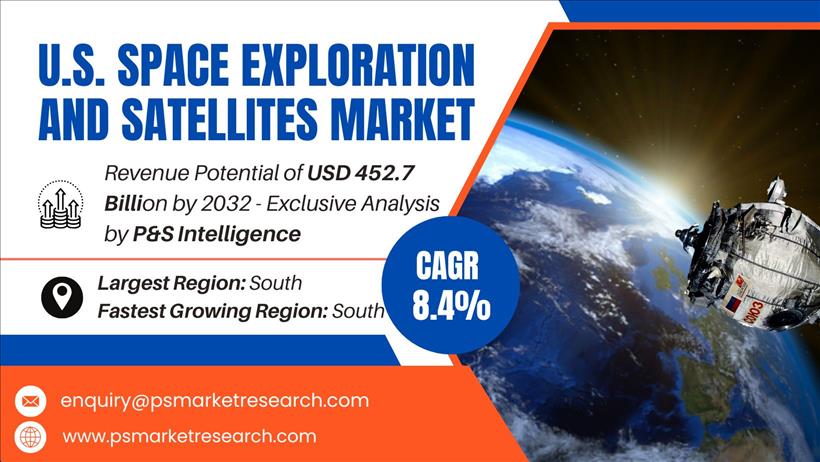Science
U.S. Space Exploration Market Set to Hit $452.7 Billion by 2032

The U.S. space exploration and satellite market is on track to reach an estimated value of USD 452.7 billion by 2032, up from USD 240.1 billion in 2024. This significant growth is projected at a compound annual growth rate (CAGR) of 8.4% from 2025 to 2032, according to a recent study by P&S Intelligence. The expansion is fueled by increased government investments, technological advancements, and the rise of commercial space activities.
Government funding plays a crucial role in this sector, with a notable increase in demand for satellite-based services in areas such as communication, navigation, and defense. Strategic partnerships and collaborations in space diplomacy further bolster these initiatives. Innovations like reusable rocket technology and the emergence of micro, nano, and modular satellites are also enhancing accessibility for private enterprises.
Market Segmentation and Trends
As of 2024, the low Earth orbit (LEO) segment accounted for over 55% of the market share. This popularity is largely attributed to the demand for broadband connectivity, earth observation, and scientific missions. Companies like SpaceX and Amazon’s Kuiper Systems have initiated the deployment of extensive satellite constellations, capitalizing on the affordability and efficiency of LEO satellites.
In contrast, the medium Earth orbit (MEO) segment is expected to witness the fastest growth. MEO satellites are increasingly utilized in GPS and broadband applications, striking an ideal balance between coverage and signal strength, making them suitable for both military and commercial applications.
Heavy-lift launch vehicles dominated the market with a 40% share in 2024. Their capacity to transport large payloads for deep-space missions and satellite constellations is unmatched. A significant example is the planned launch in April 2025, which aims to deploy 27 Kuiper satellites using the ULA Atlas V 551 rocket. Meanwhile, small-lift launch vehicles are anticipated to achieve the highest CAGR, driven by the increasing popularity of CubeSats and microsatellites.
Satellites themselves represented the largest payload type in 2024, comprising 75% of the market. Their essential roles in communication, navigation, earth observation, and defense underscore their significance. Noteworthy progress has been made by Amazon and OneWeb in their satellite network deployments.
Future Prospects and Innovations
The demand for testing probes is expected to grow rapidly, supported by NASA’s Commercial Lunar Payload Services (CLPS) program and a heightened interest in planetary exploration. The communication segment emerged as a leader in the market, holding a 45% share. This growth is driven by the increasing need for high-speed internet and the integration of 5G technologies. Initiatives like AST SpaceMobile’s Direct-to-Device services and T-Mobile’s partnership with SpaceX illustrate the ongoing advancements in this area.
The navigation segment is also set for rapid expansion, fueled by the growing reliance on GPS and GNSS technologies for applications such as autonomous vehicles and urban planning. Government agencies accounted for the largest end-use share in 2024, with a robust 55% share. Agencies like NASA and the U.S. Department of Defense are driving this demand with significant budget allocations, including NASA’s request for USD 18.8 billion for fiscal year 2026, focusing on lunar and Mars missions.
On the commercial side, the sector is poised for the fastest growth as private entities increasingly engage in satellite launches and deep-space exploration. Regionally, the South of the United States led the market in 2024 and is expected to continue its dominance through 2032, benefiting from major spaceports and research hubs in states like Texas and Florida.
The market remains consolidated, with key players such as SpaceX, Lockheed Martin, Boeing, Northrop Grumman, Blue Origin, and Rocket Lab leading through proprietary technology and federal contracts. Recent developments include SpaceX’s launch of 26 Starlink satellites in May 2025 and Blue Origin’s collaboration with AST SpaceMobile to enhance terrestrial connectivity via the New Glenn rocket. Additionally, Boeing announced plans for a quantum internet demonstration via the Q4S satellite in 2026.
As the U.S. space exploration and satellites market continues to grow, the interplay of government support, technological innovation, and private sector engagement promises to reshape the landscape of space activities for years to come.
-

 Politics4 weeks ago
Politics4 weeks agoSecwepemc First Nation Seeks Aboriginal Title Over Kamloops Area
-

 World5 months ago
World5 months agoScientists Unearth Ancient Antarctic Ice to Unlock Climate Secrets
-

 Entertainment5 months ago
Entertainment5 months agoTrump and McCormick to Announce $70 Billion Energy Investments
-

 Science5 months ago
Science5 months agoFour Astronauts Return to Earth After International Space Station Mission
-

 Lifestyle5 months ago
Lifestyle5 months agoTransLink Launches Food Truck Program to Boost Revenue in Vancouver
-

 Technology3 months ago
Technology3 months agoApple Notes Enhances Functionality with Markdown Support in macOS 26
-

 Lifestyle3 months ago
Lifestyle3 months agoManitoba’s Burger Champion Shines Again Amid Dining Innovations
-

 Top Stories2 months ago
Top Stories2 months agoUrgent Update: Fatal Crash on Highway 99 Claims Life of Pitt Meadows Man
-

 Politics4 months ago
Politics4 months agoUkrainian Tennis Star Elina Svitolina Faces Death Threats Online
-

 Sports5 months ago
Sports5 months agoSearch Underway for Missing Hunter Amid Hokkaido Bear Emergency
-

 Politics5 months ago
Politics5 months agoCarney Engages First Nations Leaders at Development Law Summit
-

 Technology5 months ago
Technology5 months agoFrosthaven Launches Early Access on July 31, 2025




















